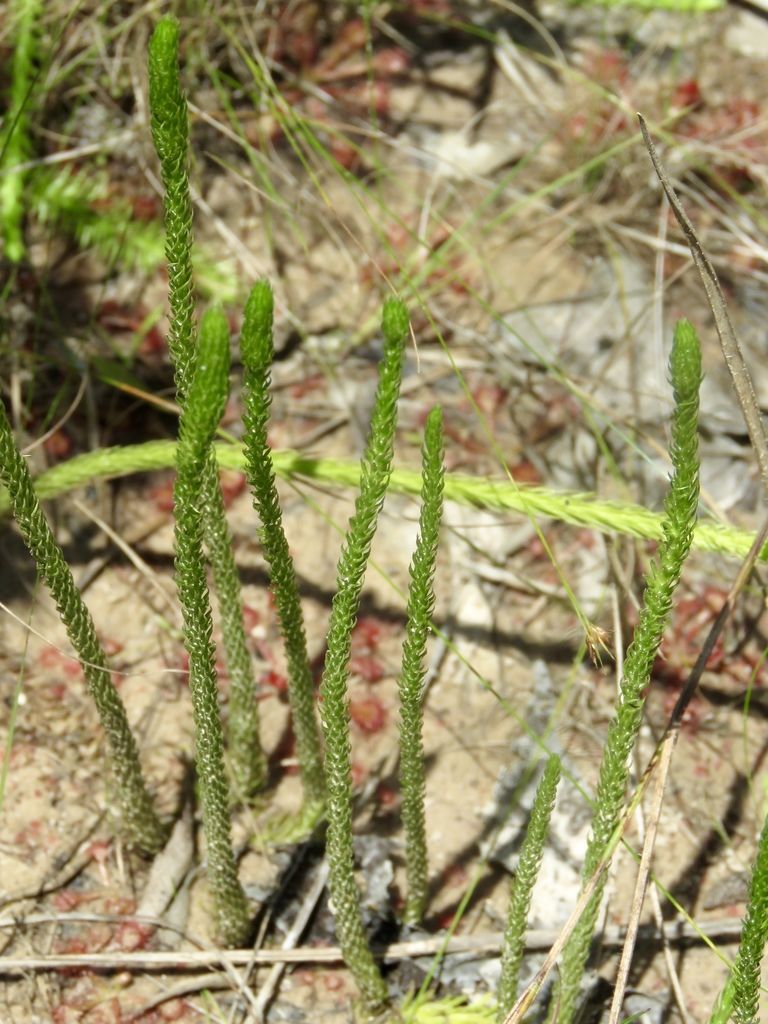Family: Lycopodiaceae
Author: (Chapm.) Cranfill
Bibliography: Amer. Fern J. 71: 97 (1981)
Year: 1981
Status: accepted
Rank: species
Genus: Lycopodiella
Vegetable: False
Observations: E. Canada to C. & E. U.S.A., Cuba
Description
The Southern bog clubmoss, scientifically known as Lycopodiella appressa, is a distinctive and fascinating plant belonging to the family Lycopodiaceae. This perennial herbaceous plant captures interest with its unique morphology and adaptability to wet environments, such as bogs and marshes, predominantly found across its wide geographical range, including Eastern Canada, Central and Eastern United States, and Cuba.
Lycopodiella appressa typically thrives in moist, acidic soils where it often forms dense mats, contributing to the intricate ecosystems of bogs and other wetland areas. The plant’s stoloniferous growth habit allows it to propagate efficiently, spreading horizontally to colonize new areas. This characteristic growth pattern supports soil stabilization and provides essential habitat for various microfaunal species.
The shoots of the Southern bog clubmoss are characterized by their finely divided, needle-like leaves that give the plant a lush, green appearance. These leaves are closely appressed, or lying flat along the stem, a feature that is not only reflected in the plant’s scientific name but also contributes to its common name. The stems extend horizontally or ascend slightly, anchoring themselves into the wet substrate with the assistance of delicate, fibrous roots.
One notable aspect of Lycopodiella appressa is its reproduction via spores rather than seeds, a common trait among clubmosses. Sporangia, or spore-producing structures, are borne terminally on specialized leaves known as sporophylls. These sporophylls cluster together to form strobili, or cone-like structures, at the tips of the branches. The spore release process plays a significant role in the plant’s propagation and genetic diversity, contributing to the resilience and adaptability of this species.
Ecologically, the Southern bog clubmoss supports local biodiversity by providing ground cover and habitat complexity. Its presence in wetland ecosystems aids in water retention and nutrient cycling, crucial for maintaining the health and integrity of these habitats. Furthermore, its dense mats can inhibit the establishment of invasive species, thus preserving the native flora’s composition and dynamics.
The scientific community has taken an interest in Lycopodiella appressa, acknowledging its role in wetland ecosystems and its evolutionary significance as an ancient plant lineage. Published research, such as the study by American botanist Cranfill in the American Fern Journal in 1981, has deepened the understanding of its distribution, morphology, and ecological importance.
Given its unique features and ecological role, the Southern bog clubmoss is considered a valuable species for conservation efforts, particularly in regions where wetland habitats are threatened by human activity and climate change. Its conservation not only aids in safeguarding wetland ecosystems but also ensures the preservation of a plant lineage that has contributed to the planet’s botanical heritage for millions of years.
Common Names
Eng: southern bog clubmoss, appressed bog clubmoss, swamp clubmoss
Fra: lycopode apprimé
En: Southern bog clubmoss, Southern Appressed Club-Moss, Appressed bog clubmoss, Swamp clubmoss
Fr: Lycopode apprimé
Synonyms
- Lycopodium inundatum var. appressum (Chapm.)
- Lycopodium alopecuroides f. appressum ((Chapm.) Clute)
- Lycopodium adpressum f. polyclavatum (McDonald)
- Lycopodium alopecuroides var. appressum (Chapm.)
- Lycopodiella bigelowii ((Tuck.) Holub)
- Lycopodium alopecuroides f. polyclavatum (Clute)
- Lycopodium alopecuroides subsp. appressum ((Chapm.) Clute)
- Lycopodium inundatum f. polyclavatum ((McDonald) Fernald)
- Lycopodium alopecuroides var. chapmanii (Clute)
- Lycopodium inundatum var. bigelowii (Tuck.)
Distribution
- Alabama (native)
- Arkansas (native)
- Connecticut (native)
- Cuba (native)
- Delaware (native)
- District of Columbia (native)
- Florida (native)
- Georgia (native)
- Illinois (native)
- Indiana (native)
- Kansas (native)
- Kentucky (native)
- Louisiana (native)
- Maine (native)
- Maryland (native)
- Masachusettes (native)
- Mississippi (native)
- New Hampshire (native)
- New Jersey (native)
- New York (native)
- Newfoundland (native)
- North Carolina (native)
- Nova Scotia (native)
- Oklahoma (native)
- Pennsylvania (native)
- Prince Edward I. (native)
- Rhode I. (native)
- South Carolina (native)
- Tennessee (native)
- Texas (native)
- Vermont (native)
- Virginia (native)
- West Virginia (native)
Additional Images
Habit
Taken Nov 21, 2021 by Busy bee (cc-by-sa)
Leaf
Taken Nov 21, 2021 by Busy bee (cc-by-sa)
Taken Nov 21, 2021 by Busy bee (cc-by-sa)

© copyright of the Board of Trustees of the Royal Botanic Gardens, Kew.
Sources
- WFO (No URL)
- IPNI (No URL)
- GBIF (https://www.gbif.org/species/2688350)
- POWO (http://powo.science.kew.org/taxon/urn:lsid:ipni.org:names:146930-2)
- PlantNet (https://identify.plantnet.org/species/the-plant-list/Lycopodiella appressa (Chapm.) Cranfill)
Specifications
Growth habit>: Subshrub, Forb/herb



